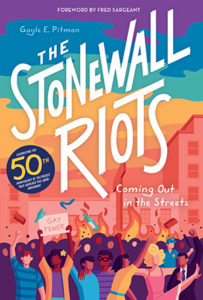
BOOK REVIEW: ‘The Stonewall Riots’
Coming out in the streets.
To anybody else, that tchotchke would be worthless. To you, though, it oozes with memories, and you keep it because it represents special people, remarkable times, or things you hold in your heart. One glance, and you instantly recall something you want to remember.

So it is with Gayle E. Pitman’s The Stonewall Riots, which takes a look at 50 objects that recall a pivotal moment in LGBTQ history in a way that children can relate to. Using photographs, matchbook covers, clothing, and other ephemera, author Gayle E. Pitman turns the Stonewall Rebellion into something relatable for its intended audience—because, as you know, kids are big on keeping mementos and special objects.
Pitman notes that written accounts of history can get “complicated—especially if that story differs depending on who tells it.” That’s what happened in at least part of the tale of gay liberation: few records were kept, newspapers were mostly silent, and key players have died. Even so, she says, there are enough objects to tell a story.
She begins with a basic history of Greenwich Village in New York City, and the Jefferson Livery Stable, which housed horses long before it became Bonnie’s Stonewall Inn, and then just the Stonewall Inn. There’s a possibility, says Pitman, that the word “Stonewall” might have been “a coded welcome message to lesbians.”

Back then, being gay or lesbian meant almost certain persecution, but a gay man named Harry Hay and three of his friends knew that the best way to work against discrimination was to organize. They started The Mattachine Society in 1950, and Pitman includes a photo of one of their early meetings. Five years later, Del Martin and Phyllis Lyon started the Daughters of Bilitis, an organization for lesbians.
But still the discrimination continued, and “in 1966, resistance was in the air.” African-Americans had been fighting for civil rights for “quite some time,” and antiwar protests were just starting to organize. Small uprisings had been staged on behalf of LGBTQ people in California, while in New York City, LGBTQ individuals were getting pretty tired of police harassment, Mafia shake-downs, and raids on their hangouts.
And on June 28, 1969, their simmering anger boiled over.
Through the stories she tells about the book’s 50 selected items, Pitman explains the events surrounding the night of the riot. She also draws a few threads between then and now, but she’s careful not to be too hasty in filling in historical blanks. Those unknowns will leave kids hanging a bit, but the gaps can heighten the excitement and outrage about what happened.
While this is a book for children ages 10 and up, it’s also for anyone under the age of 55 who wouldn’t remember news of the Stonewall riots firsthand. For that audience, reading The Stonewall Riots is absolutely worthwhile.
This article appears in the June 2019 edition of OutSmart magazine.











Comments